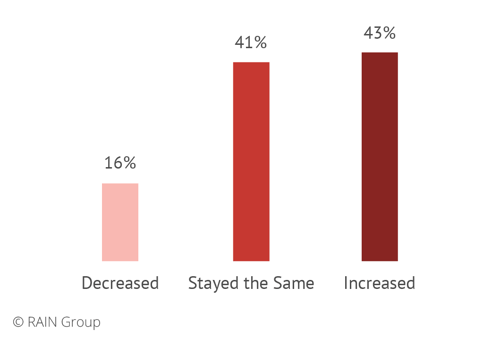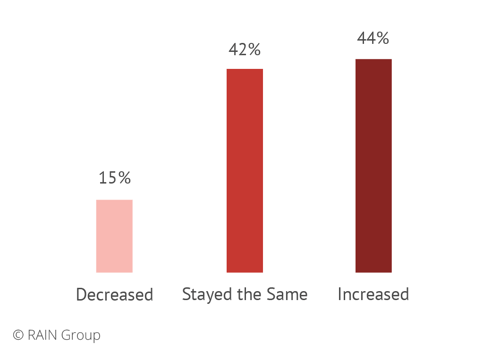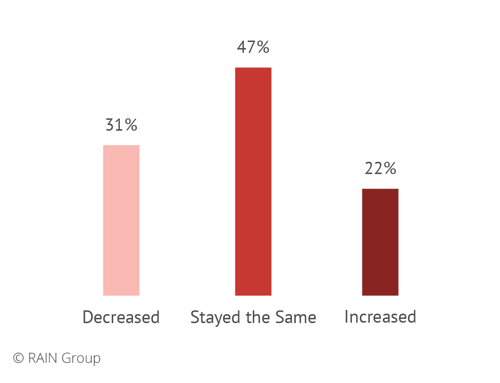Are you finding the sales cycle is getting longer? Increases in loss to the dreaded “no decision”? Difficulty selling in an uncertain economy?
You're not alone.
In fact, you have a lot of company. Research shows that sales cycles are getting longer and more opportunities are being lost to no decision while economic uncertainty looms. As the adage goes, time kills sales.
In this post, I’ll explore what’s happening and share some advice on how to drive urgency and stay top of mind.
Which skills are necessary for an effective sales cycle? Find out here. >>
The Sales Cycle Is Getting Longer
RAIN Group’s research shows 43% of sales and enablement leaders report the sales cycle has increased, while only 16% say it’s decreased. This trend has serious implications for sellers because, as sales cycles lengthen, the number of buyers who decide to do nothing tends to increase.
Overall, in the past 12 months, the sales cycle time for deals has:

To compound matters, as the sales cycles lengthen, more decision makers are being introduced. Eighty-five percent of sales and enablement leaders report that dealing with an increased number of decision makers in buying organizations is at least somewhat challenging. This makes it more difficult for sellers to push deals forward and close sales.
More Companies Are Losing to No Decision
Another alarming trend is that more opportunities are being lost to no decision. Forty-four percent of leaders say the percentage of opportunities lost to no decision has increased compared to only 15% who say it’s decreased.
Overall, how has the percentage of opportunities the sales force proposed or quoted on and lost to no decision changed?

At the same time, 31% say that losing to competitors has decreased while only 22% say losing to competitors has increased.
Overall, how has the percentage of opportunities the sales force proposed or quoted on and lost to competitors changed?

These findings suggest it’s no longer enough to differentiate against your competition to win. Instead, you also must drive an increasing amount of urgency for buyers to move forward and to move forward faster.
The saying holds true: time kills sales.
So, what can you do to drive urgency and stay top of mind in a long sales cycle?
5 Tips to Drive Urgency with Buyers
1. Ask, "What won't happen?"
Fear is a powerful motivator, and by facilitating a conversation around what won't happen, you can increase a buyer's desire to make it happen. This fosters a sense of FOMO (fear of missing out) and can help move sales forward.
2. Develop champions on the buyer team
A champion will advocate for your solution even when you aren't in the room. They can help you navigate the buying process and overcome objections. The best sellers know this and proactively develop relationships with champions.
Having multiple champions within an organization also helps insulate you from staffing changes, as well as giving entrée into different areas of an organization to support account growth and development.
All the better if one of your champions is a decision maker in your target organization. Sellers can be too cautious when approaching organizations; it's worth aiming high. In any case, learn the buying roles as soon as you can to make sure you aren't blindsided by a decision maker you haven't spoken to.
3. Make a strong impact case
You need to communicate the impact your solution will have on the buyer and do it in such a way that they, too, can make the case for what you're selling to themselves and other stakeholders. By getting the buyer involved in making the case, you get them to take ownership of ideas and help move the sale forward.
To do this, be sure to answer the four value proposition questions:
- Why act?
- Why now?
- Why us?
- Why trust?
Buyers need to be able to answer these four questions before they’ll buy. If they don't have a strong answer to any of the four whys, they’ll delay the purchase because there either isn’t a compelling enough reason to move forward or it's too risky.
Specifically, "Why now?" deals with urgency and the reasons why acting sooner than later is beneficial. But you must attend to each of the whys to build the strongest value and impact case.
When you do, you'll resonate (speak to need), differentiate (why you), and substantiate (prove you can do it).
4. Create urgency during negotiations
Offer a trade you think might get them to move faster. This could be a discount, additional services, or something else of value to the buyer.
To be clear: I am not suggesting a straight discount to win. When we talk about negotiation, essential rule #5 is trade, don’t cave. This means asking for something in return when something is asked of you. Maybe it’s a discount along with an agreement that the buyer publishes a case study with you or agrees to co-present at a conference.
The idea is you can drive urgency with trades.
5. Start small
A great way to shorten the sales cycle on larger deals is to break them into phases, focusing on closing a smaller phase first. Once a buyer agrees to begin, it's much easier to get them to move forward with subsequent pieces of the deal.
Even if the steps are small, you want to keep the sale moving. To do so, go into every conversation with an objective and plan. Ask yourself:
- What is my goal for this prospect?
- What is my goal for this conversation?
- What are my strengths going in?
- What are my vulnerabilities?
- Based on the answers, what can I expect and what is my planned next step?
5 Strategies to Stay Top of Mind with Buyers
In addition to driving urgency, it's important to stay top of mind during a long sales cycle. Following are five strategies to help.
1. Employ Big Plays when it's a big deal
A Big Play is a bold, atypical action a seller can take to inspire a buyer to act and set themselves apart from the competition. They can be risky, but for significant opportunities, it can be well worth the investment. Examples include partnering with a buyer to co-create value, contingency pricing, guarantees, site visits, complimentary consultations, and so on.
The idea is the Big Play will help strengthen your relationship with key buyers and maximize the buyers’ perception of the value of moving forward with you.
2. Provide value in every touch
Sales leaders recognize the importance of this—improving the ability to communicate value is a top priority for 70% of sales and enablement leaders surveyed. A great way to do this is to offer value in every touch.
Leverage your own marketing and industry knowledge to direct buyers to relevant materials related to their needs. Examples include research, customized content, market trends insights, case studies, and so on.
To get to the point where you can provide consistent value to buyers, you'll need to uncover a prospect's aspirations and afflictions. This means asking powerful questions that uncover a buyer's full suite of needs. Often, these needs will go deeper than their stated solution for a problem.
If you can demonstrate that you have a solid understanding of your buyers, it eases solution crafting and engenders trust.
One way to proactively demonstrate your understanding of buyer needs and generate excitement is by crafting a Buyer Change Blueprint (BCB). Your BCB is a bespoke document that contrasts your buyer's current state with the possibilities introduced by your solution. Often, you can present your BCB as a prelude to a larger proposal to get your buyer excited and give them an overview of your solution and its impact.
3. Reach out often
If you want to stay top of mind during the long sales cycle, reach out frequently. Sellers often tell us they’ve been ghosted by a buyer. Maybe they’ve sent three emails and received no response. Typically, we’ll then ask, “Did you call? Leave a message? Comment on a LinkedIn post? Talk to your champion? Reach out to others on the buying team?”
You can quickly see how three emails to one buyer may not be enough to push a buyer forward.
On average, it takes 8 touches to generate a conversation with a new buyer. Staying persistent at any point in the sales cycle can be challenging, but if you don't set a rhythm for your outreach, you might lose sales you would've otherwise won if you'd stuck with it.
4. Reach out across multiple media
Use multiple channels, such as phone, email, social media, and messaging, to stay in touch and provide value. B2B sales are no longer limited to a single channel, so use this to your advantage.
5. Deepen your relationships across the buyer account
Having multiple relationships helps to strengthen the overall relationship with an account and can open the door to bigger and more secure deals.
The most successful sellers know this. In fact, research from LinkedIn has shown that the highest performing sales reps are 13% more likely to proactively develop new relationships within an account, also known as multi-threading.
By following these tips and strategies, you can drive urgency with buyers and stay top of mind during a long sales cycle. Don't let time kill your sales—take action and move forward faster!








